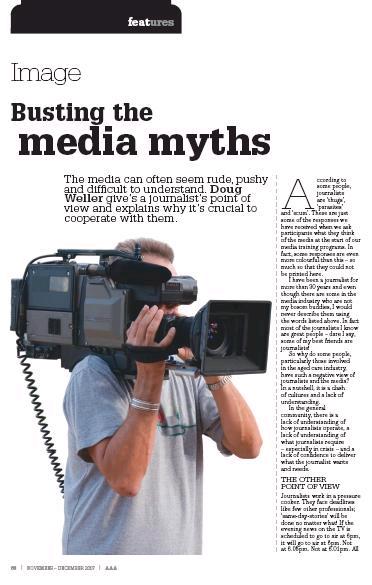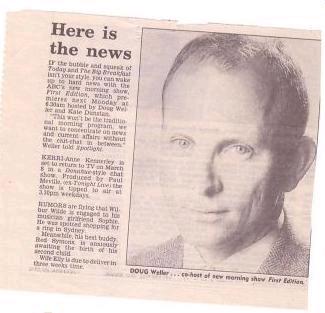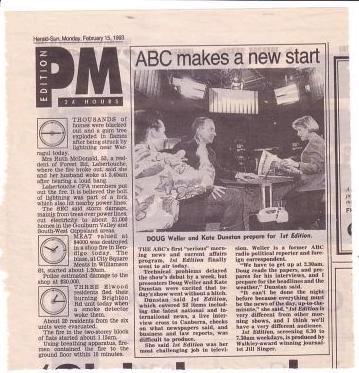Busting the Media Myths
Busting the Media Myths
Published: November/December 2007
Publication: AAA
Author: Doug Weller
Pages: 66-67
Words: 989
Image of article: Shown below
**START TRANSCRIPT**
Busting the media myths
The media can often seem rude, pushy and difficult to understand. Doug Weller give’s a journalist’s point of view and explains why it’s crucial to cooperate with them.
According to some people, journalists are ‘thugs’, ‘parasites’ and ‘scum’. These are just some of the responses we have received when we ask participants what they think of the media at the start of our media training programs. In fact, some responses are even more colourful than this – so much so that they could not be printed here.
I have been a journalist for more than 30 years and even though there are some in the media industry who are not my bosom buddies, I would never describe them using the words listed above. In fact most of the journalists I know are great people – dare I say, some of my best friends are journalists!
So why do some people, particularly those involved in the aged care industry, have such a negative view of journalists and the media?
In a nutshell, it is a clash of cultures and a lack of understanding. In the general community, there is a lack of understanding of how journalists operate, a lack of understanding of what journalists require – especially in crisis – and a lack of confidence to deliver what the journalist wants and needs.
THE OTHER POINT OF VIEW
Journalists work in a pressure cooker. They face deadlines like few other professionals; ‘same-day-stories’ will be done no matter what! If the evening news on the TV is scheduled to go to air at 6pm, it will go to air at 6pm. Not at 6.05pm. Not at 6.01pm.
66 | NOVEMBER – DECEMBER 2007 | AAA
All mediums face deadlines and they are sacrosanct. This means, as journalists get closer to those deadlines the pressure increases. And if you refuse to comment on a story, especially in a crisis, journalists will become hostile. They will gather what they require – comments, vision, photos – any way they can. By frustrating journalists who are under pressure to produce a story, you simply ensure the journalist is upset and angry with you when writing that story. That’s not a good move.
Journalists will always meet their deadline! There is no other option. If a journalist, cameraperson or photographer tells an editor they are unable to get what was required to meet the deadline, it is a career destroying move.
THE WRONG RESPONSE
After many years of training people how to deal with the media I believe that most people actually want to comment to the media in a crisis, yet instead, as the pressure increases it all becomes too hard and they say “lock the gates”.
Locking the gates, locking the doors, calling security or the police to keep the media away when you are dealing with a crisis, is an understandable and very normal human reaction. But it causes problems.
If the media is interested in a story relating to your aged care facility it will probably be because you are facing a very difficult situation. It could even involve the death of a resident. The bigger the issue, the bigger the story for the media and the less you may want to talk. However, it should be the other way around. The bigger the issue, the bigger the story, the more interested you should be in speaking to the media.
GIVING THE MESSAGE
You see, it’s not the media on which you need to focus, it is the audience. The media is simply the vehicle by which the message is delivered to that audience. By shutting out the media, you shut out the audience, often when you need to reassure that audience. “No comment” is not a good look, especially in a crisis.
What did you think of the company that last delivered via the media, a curt message of “no comment”? There is always something an aged care facility spokesperson can say. What you need is a formula: a set of words – a process if you like – that will allow them to communicate their message, even when they know very little about a crisis, or can only give very limited comment.
They need to respond quickly. They need to look in control, and appear neat, tidy and confident. They need to deliver a set of words which express concern and action being taken. It doesn’t have to be very long. It just needs to be delivered.
A TELLING EXAMPLE
Some years ago I was covering the story of a death in a residential facility. When I rang the complex the woman on the switch was obviously under pressure and she insulted me, hanging up in my ear. When I arrived with my TV crew we were insulted again and had the gates locked on us. The more the other journalists and I attempted to gain a comment, the more the aged care facility management resisted.
In the end we had TV news helicopters flying above the facility to gather vision. For verbal comment we interviewed family members of those inside the facility. Their comments about the facility were not complimentary.
Without much effort the facility management could have easily handled the situation in a way, which made them look professional, caring and pro-active. The opposite was the case. By the way, on that day we all met our deadline.
For more information contact Doug Weller at djweller@bigpond.net.au or visit his website: www.corporatemediaservices.com.au – see also Gerard Mansour’s state view on dealing with the media on page 25.
DOUG WELLER will be speaking at the Retirement Village Association’s (RVA) National Conference on how to work with the media. The AdvantAGE 07 Conference will be held in Melbourne from 13-15 November at the Grand Hyatt Melbourne, Victoria. For more information, visit www.rvadvantage.com.au
‘The bigger the issue, the bigger the story, the more interested you should be in speaking to the media.’
‘Doug Weller’
‘By the way, on that day we all met our deadline.’
AAA | NOVEMBER – DECEMBER 2007 | 67
**END TRANSCRIPT**

Make an enquiry now or call us on 1300 737 913 or +61 412 298 905



